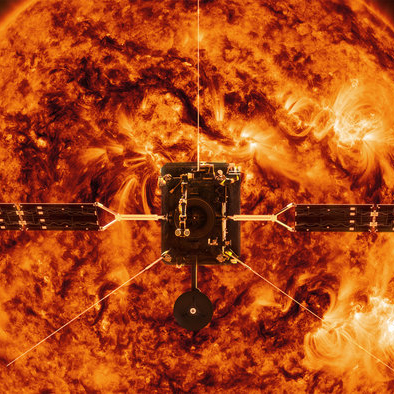The Sun has a tremendous influence on the Earth’s atmosphere/magnetosphere and on future technological development of our civilization. At the solar surface (in the photosphere) the temperature reaches several thousand degrees increasing up to one million degrees in the higher atmosphere (the corona). The mechanism of the plasma heating is not yet understood. One possible mechanism for heating the coronal plasma is the energy transport and dissipation by Alfvén plasma waves. The Alfvén waves are produced by oscillation of magnetic field lines and have been a focus of laboratory and space plasma physics for over half a century. However, their direct detection in the solar atmosphere is complicated.
Simultaneous multi-wavelength observations from the Earth-based Dunn Solar Telescope (USA) and NASA’s Solar Dynamics Observatory revealed the first observational evidence of Alfvén shock waves and their dissipation in the solar chromosphere, i.e., the layer sandwiched between the photosphere and the corona. “The observation of Alfvén shock waves is a breakthrough in the solution of the long standing coronal plasma heating problem”, says Teimuraz Zaqarashvili, space researcher at the Austrian Academy of Sciences and co-author of the paper. “The most interesting point is that we see clear temperature enhancements during the wave propagation indicating wave dissipation”, continues Zaqarashvili.
The findings of the study will certainly stimulate future modelling and observational efforts within the framework of future missions like Solar Orbiter, which is an ESA-led mission with strong NASA participation dedicated to solar and heliospheric physics. The Space Research Institute of the Austrian Academy of Sciences in Graz is building the digital processing unit for the Radio and Plasma Waves instrument (RPW) and has calibrated the RPW antennas. Solar Orbiter will be launched in 2020.
RESOLVING THE HEATING OF THE SOLAR ATMOSPHERE

Publication:
"Dissipation of Alfvén waves in the solar chromosphere", S.T.D. Grant, D.B. Jess, T. Zaqarashvili, C. Beck, H. Socas-Navarro, M.J. Aschwanden, P.H. Keys, D.J. Christian, S.J. Houston, and R.L. Hewitt, Nature Physics, 2018
DOI: 10.1038/s41567-018-0058-3
Media enquiries
Sven Hartwig
Head of Public Relations & Communication
Austrian Academy of Sciences
Dr. Ignaz Seipel-Platz 2, 1010 Vienna
T +43 1 51581-1331
sven.hartwig(at)oeaw.ac.at
Scientific contact:
Dr. Teimuraz Zaqarashvili
Space Research Institute
Austrian Academy of Sciences
Schmiedlstraße 6, 8042 Graz
T + 43 316 4120-672
teimuraz.zaqarashvili(at)oeaw.ac.at